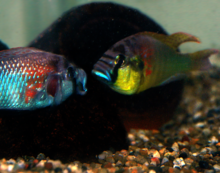| Astatotilapia burtoni | |
|---|---|

| |
| Two males dispute a territorial boundary. | |
| Scientific classification | |
| Domain: | Eukaryota |
| Kingdom: | Animalia |
| Phylum: | Chordata |
| Class: | Actinopterygii |
| Order: | Cichliformes |
| Family: | Cichlidae |
| Genus: | Astatotilapia |
| Species: | A. burtoni
|
| Binomial name | |
| Astatotilapia burtoni (Günther, 1894)
| |
| Synonyms | |
| |
Astatotilapia burtoni is a species of fish in the family Cichlidae.
It is found in Lake Tanganyika and its surrounding waterways,[2] including parts of Burundi, Rwanda, Tanzania, and Zambia.
Its natural habitats are rivers, intermittent rivers, swamps, freshwater lakes, freshwater marshes, intermittent freshwater marshes, and inland deltas.
Astatotilapia burtoni has been used as a model organism to study the behaviors and physical systems of cichlids, including their development and embryogenesis.[3] Moreover, the phylogenetic position of this particular species makes it an ideal model system for comparative genomic research. A. burtoni belongs under the haplochromines, which is the lineage of cichlids with the most species, and has been discovered to be a sister group to both the Lake Victoria region superflock (which has about 600 species) and the species flock of Lake Malawi (which has about 1,000 species).[4]
- ^ Ntakimazi, G. (2018). "Astatotilapia burtoni". IUCN Red List of Threatened Species. 2018: e.T60462A135861389. doi:10.2305/IUCN.UK.2018-2.RLTS.T60462A135861389.en.
- ^ Lang, Michael (2006). "A BAC Library of the East African Haplochromine Cichlid Fish Astatotilapia burtoni". Journal of Experimental Zoology. 306B (1): 35–44. Bibcode:2006JEZB..306...35L. doi:10.1002/jez.b.21068. PMID 16254984.
- ^ Woltering, Joost M.; Holzem, Michaela; Schneider, Ralf F.; Nanos, Vasilios; Meyer, Axel (December 2018). "The skeletal ontogeny of Astatotilapia burtoni – a direct-developing model system for the evolution and development of the teleost body plan". BMC Developmental Biology. 18 (1). doi:10.1186/s12861-018-0166-4. ISSN 1471-213X. PMC 5883283. PMID 29614958.
- ^ Salzburger, Walter; Renn, Susan; Steinke, Dirk; Braasch, Ingo; Hofmann, Hans; Meyer, Axel (25 February 2008). "Annotation of expressed sequence tags for the East African cichlid fish Astatotilapia burtoni and evolutionary analyses of cichlid ORFs". BMC Genomics. 9 (96): 96. doi:10.1186/1471-2164-9-96. PMC 2279125. PMID 18298844.
